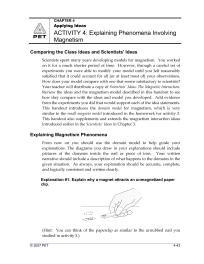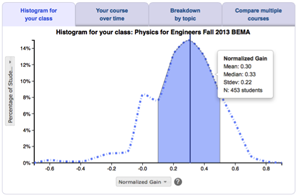
Physics and Everyday Thinking
Developed by: Fred Goldberg, Valerie Otero and Steve Robinson
Level










middle schoolhigh schoolintro collegeinter-mediateupper levelgrad school other

conceptual




middle schoolhigh schoolintro collegeinter-mediateupper levelgrad school other

conceptual
Topics






Setting






Overview
What? A guided-inquiry conceptual physics course that helps students develop a deep conceptual understanding of big ideas in physics through small groups, whole-class discussion, and laboratory work. Incorporates activities that focus on the nature of science and the nature of learning.
Topic outline
- Chapter 1: Interactions and Energy introduces students to all of the common themes of the course, in particular the themes of interactions between objects and the energy description of interactions.
- Chapter 2: Interactions and Forces introduces students to an alternative framework (that of forces) within which they can explain interactions they first see in Chapter 1 that involve objects pushing or pulling on one another.
- Chapter 3: Interactions and Fields introduces students to the ideas of "fields of influence" mediating interactions that can occur over a distance, specifically the magnetic, electric charge and gravitational interactions. The concept of potential energy is also introduced.
- Chapter 4: Model of Magnetism concentrates on the nature of science as students develop a model for magnetism, and then track its evolution among elementary students and historically, among scientists.
- Chapter 5: Electric Circuit Interactions introduces students to electric circuit interactions and how to describe electric circuits in terms of energy and current.
- Chapter 6: Light Interactions introduces students to light interactions. Students examine the interaction of light with mirrors, eyes, transparent objects, white and black objects, and objects of different colors.
Student skills developed
Designed for:
- Conceptual understanding
- Using multiple representations
- Metacognition
Can be adapted for:
- Problem-solving skills
- Lab skills
- Making real-world connections
Instructor effort required
- Medium
Resources required
- Computers for students
- Advanced lab equipment
- Cost for students
- Tables for group work
Resources
Developer's website: Physics and Everyday Thinking
Intro Article: F. Goldberg and S. Bendall, Making the invisible visible: A teaching/learning environment that builds on a new view of the physics learner, Am. J. Phys. 63 (11), 978 (1995).
Teaching Materials
You can order the PET materials from their publisher, Activate Learning. You can also download the homework and movies for free from this site.
Research
RESEARCH VALIDATION
This is the highest level of research validation, corresponding to:
- both of the "based on" categories
- at least 4 of the "demonstrated to improve" categories
- at least 5 of the "studied using" categories
Research Validation Summary
Based on Research Into:
- theories of how students learn
- student ideas about specific topics
Demonstrated to Improve:
- conceptual understanding
- problem-solving skills
- lab skills
- beliefs and attitudes
- attendance
- retention of students
- success of underrepresented groups
- performance in subsequent classes
Studied using:
- cycle of research and redevelopment
- student interviews
- classroom observations
- analysis of written work
- research at multiple institutions
- research by multiple groups
- peer-reviewed publication
References
- J. Bartley, L. Mayhew, and N. Finkelstein, Promoting Children’s Understanding and Interest in Science Through Informal Science Education, presented at the Physics Education Research Conference 2009, Ann Arbor, Michigan, 2009.
- S. Belleau and V. Otero, Critical Classroom Structures for Empowering Students to Participate in Science Discourse, presented at the Physics Education Research Conference 2012, Philadelphia, PA, 2012.
- S. Belleau, M. Ross, and V. Otero, Implementation of physics and everyday thinking in a high school classroom: Concepts and argumentation, presented at the Physics Education Research Conference 2011, Omaha, Nebraska, 2011.
- F. Goldberg and S. Bendall, Making the invisible visible: A teaching/learning environment that builds on a new view of the physics learner, Am. J. Phys. 63 (11), 978 (1995).
- D. Harlow, How Elementary Teachers Use What We Teach: The Impact Of PER At The K-5 Level, presented at the Physics Education Research Conference 2007, Greensboro, NC, 2007.
- D. Harlow, V. Otero, A. Leak, S. Robinson, E. Price, and F. Goldberg, Learning about teaching and learning while learning physics: An analysis of 15 years of responsive curriculum development, Phys. Rev. Phys. Educ. Res. 16 (2), 020155 (2020).
- D. Harlow, L. Swanson, H. Dwyer, and J. Bianchini, Learning Pedagogy in Physics, presented at the Physics Education Research Conference 2010, Portland, Oregon, 2010.
- J. Keil, N. Schrode, and R. Stober, Physics Instruction That Facilitates Learning Among Underrepresented Groups, presented at the Physics Education Research Conference 2017, Cincinnati, OH, 2017.
- V. Otero and K. Gray, Learning to Think Like Scientists with the PET Curriculum, presented at the Physics Education Research Conference 2007, Greensboro, NC, 2007.
- V. Otero and K. Gray, Attitudinal gains across multiple universities using the Physics and Everyday Thinking curriculum, Phys. Rev. ST Phys. Educ. Res. 4 (2), 020104 (2008).
- S. Robinson, V. Otero, and F. Goldberg, Design principles for effective physics instruction: A case from physics and everyday thinking, Am. J. Phys. 78 (12), 13 (2010).
- M. Ross and V. Otero, Challenging traditional assumptions of secondary science through the PET curriculum, presented at the Physics Education Research Conference 2012, Philadelphia, PA, 2012.





